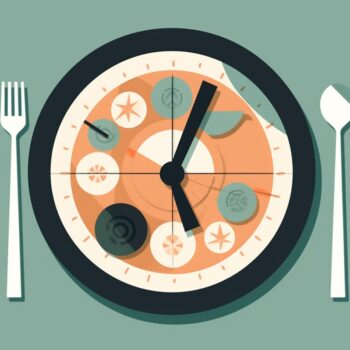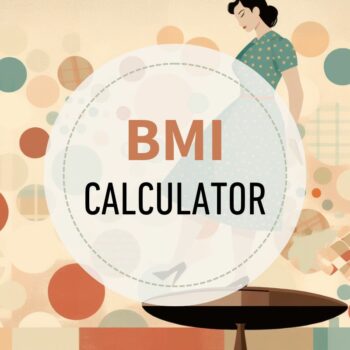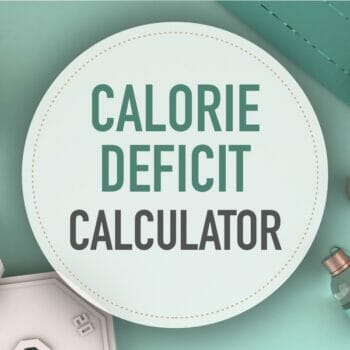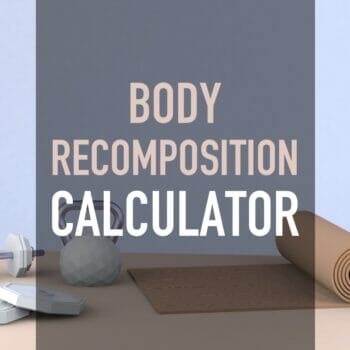TDEE Calculator
Use this TDEE calculator to quickly find your Total Daily Energy Expenditure (daily calorie needs).
Why is TDEE important?
Your TDEE (Total Daily Energy Expenditure) tells you exactly how much you must eat daily to maintain weight.
- Eat more than this, and you will gain weight.
- Eat less, and you will lose weight
This is called a calorie deficit – calculate it here.
Is TDEE and BMR the same?
No, they are not.
Every day your body burns a specific number of calories just by existing. This is known as your Basal Metabolic Rate or BMR.
BMR is based on weight, height, and age but does not include daily activity or exercise.
TDEE is effectively your BMR + extra exercise or activity.
TDEE and BMR are not the same, and as most people do more than lie in bed each day, TDEE is a more helpful tool.
Should I eat my TDEE to lose weight?
No. Your TDEE shows you your daily maintenance calories. If you eat your TDEE, you will stay the same weight.
How do you calculate TDEE for weight loss?
You lose weight by having a calorie deficit.
A calorie deficit means eating less than your body needs to maintain itself.
Ever had more bills than you had money? You had a financial deficit.
A calorie deficit is consuming less energy than you need to stay the same weight.
TDEE Weight Loss Example
Let’s say your BMR is 1,700 calories per day. With some physical activity, you end up with a TDEE of 2,300 calories.
To lose weight, you should consume around 1,840 calories per day.
How much should I subtract from TDEE?
After working with hundreds of successful clients, we’ve found a deficit of 20% from your TDEE is optimum.
You can also achieve a deficit by burning more calories through exercise.
Every effective diet, whether high fat, low fat, high carb, or low carb, uses a calorie deficit to achieve weight loss.
Why shouldn’t I subtract more calories?
Technically you could eat nothing all day and achieve weight loss through having a calorie deficit.
Many well-publicized crash diets put you into a severe caloric deficit. They result in short-term weight loss but will damage your metabolism.
Reducing your calories by more than 20% may lead to muscle loss. This is not desirable as muscle helps burn additional calories.
How long does it take to see results from a deficit?
There are 3,500 calories in a pound of fat, so with a 20% calorie deficit, most people will lose about a pound a week.
Your body can become conditioned to repeated exercise affecting your calorie intake and TDEE.
Not sure of the best path to achieving your health and fitness goals?
So switch things up from time to time! Change exercise routines, intensity, and duration.

How to get results with TDEE and a calorie deficit
Macro counting is a great way to hit your daily calorie target. You lose weight healthily and sustainably.
Counting macros (and flexible dieting) is non-restrictive. It means you still eat your favorite foods – provided they fit within your TDEE and macro goals.
You could eat unhealthy foods and still achieve weight loss. – as demonstrated by the 27-pound weight loss of Dr. Mark Haub.
However, loading your diet with fresh veggies, fruits, nuts, seeds, and lean meats is best. This way, you can feel awesome AND achieve weight loss.
TDEE FAQs
Does it matter what I eat if I count calories?
Yes and no.
You could eat nothing but snack cakes or pizza and still lose weight – if you maintain a calorie deficit.
However, for healthy body composition, a balanced diet is recommended.
Tracking macros will ensure you get enough of each macronutrient and meet micronutrient needs.
Does TDEE include exercise?
Yes, the TDEE is your total daily energy expenditure, so it must include all your movement in 24 hours.
Even non-exercisers are still doing activities around the house – eating, showering, running errands, etc.
Don’t confuse TDEE with Resting Energy Expenditure (REE) or Basal Metabolic Rate (BMR). These two represent energy expenditure if you lay in bed all day and did nothing.
How do I measure my TDEE and calorie intake?
Use the calculator above. It uses the most common variables.
If you want a genuinely accurate TDEE – talk to a coach.
Totaling your calories for the day is usually done with a macro tracking app.
How often should I recalculate my TDEE?
It would be best if you recalculated your TDEE as you lost weight. Do this every 6-8 weeks.
Does this have anything to do with BMI?
Body Mass Index or BMI is a measure of height and weight. It’s not the same thing as TDEE.
How do I use TDEE to gain muscle?
Once you’ve calculated your TDEE in the calculator above, add 10% to the calorie amount. The new calorie amount gives you a good starting point for weight gain.
If you still aren’t gaining, move this to a 20% surplus (use the macro calculator).
View article sourcesSources
- Rising, R., Harper, I. T., Fontvielle, A. M., Ferraro, R. T., Spraul, M., & Ravussin, E. (1994). Determinants of total daily energy expenditure: variability in physical activity. The American journal of clinical nutrition, 59(4), 800-804. study link
- Schulz, L. O., & Schoeller, D. A. (1994). A compilation of total daily energy expenditures and body weights in healthy adults. The American journal of clinical nutrition, 60(5), 676-681. study link
470 Comments


 Menopause Macro Calculator
Menopause Macro Calculator Intermittent Fasting Calculator
Intermittent Fasting Calculator BMI Calculator
BMI Calculator Calorie Deficit Calculator
Calorie Deficit Calculator Body Recomposition Calculator
Body Recomposition Calculator
So I am 33 currently weigh 325 and am 5’1. I am pretty sedentary but am trying to become more active little bit at a time. My fitness pal has me at 1633 calories a day to loose weight but your calculator has my TDEE at 2544. Which if I eat at a 500 deficit would put me at 2000. Should I start at the 2000 and work my way down over time or continue at the 1600 that MFP has me at. I want it to be sustainable long term as I obviously have alot to loose.
Hi Jessica, Since this calculator isn’t adjusting for your fat tissue weight it will show higher numbers for those that have a lot of weight to lose. I would advise that you go with the MFP numbers as it seems more in line with what you should be eating for weight loss. I usually recommend that people in your position have their numbers calculated by an expert. Fat tissue is low metabolic tissue so it skews standard calculations. All the best with your journey and it’s great you’re on the path to better health.
Hiya iam a female aged 30 weighing 13stone 12.. and 5ft 8. I have used the calculator which states my TDEE is 2558 .. i have a mixed lifestyle of being active walking and the gym and two jobs one of which is not an active job alot of sitting down.. id like to lose around 2 stone would i be right in thinking i need to calorie deficit of 2000? So reducing by 500? I cant get my head around it iv tried to work it out but im confused thanks in advance
Hi Ashleigh, It seems like you may be overestimating your energy output a tad. You can get a better idea of your calorie burn here: Calories Burned and Activity Calculator you can then use that info with my macro calculator to establish a safe deficit. Flexible Dieting Macro Calculator If you need me to help, I can do all the calculations for you so check out my coaching page.
Hi
Thank you so much for this information.
Ok…I want to make sure I am doing this correctly ….My TDEE per the calculator is 2450 and the zig zag BMR recommendation from the suggested BMR link is between 1586 and 1938. The suggested BMR calorie intake is just a little less than the suggest 500 calorie deficit. So which should I work towards….2450-500 or the zig zag BMR at between 1586 and 1938. I’m leaning towards the zig/zag.
Tha is in advance
Hi Tamieka, I think you should head over to my macro calculator which will calculate a 20% deficit. Also, it is best if your TDEE aligns with your energy output and not some random “zigzag”. Eat more on days you’re active and less on days you are more sedentary.
I’m going to give this a try. I have been on a fat burning program since June 1, 2020, and although it has been working I seem to be losing that last little bit of belly fat at a few grams a day now, and it’s just not totally disappearing. Don’t get me wrong though…it has been disappearing, but it appears that my metabolism is so low now that this last little bit of fat is disappearing at an excruciatingly slow pace.
I have read a few articles on this subject and a some of them focus on eating close to one’s TDEE (but staying under) as one’s metabolism might be so slow at this point that this is probably the rate that one is losing that last bit of belly fat anyway.
I experimented with this fat lost at 1850 calories per day since the beginning of August (2000 calories per day from June 1st to August 1st), but I’m now thinking that this may have been a bit too extreme, and the body just felt as though it was starving; hence, it went into fat conservation mode. As my calculated TDEE here (on this site) is 2747 calories, I’m going to experiment starting today and increase my calories to 2250 per day as this will put me at a 500 calorie deficit based on this current TDEE. Perhaps my body won’t think it’s being starved anymore and get on with this fat loss.
I workout all week long, but most of my workouts involves my weight-training program at home. I ride my bike to and from work and I count that as my HIIT workout twice a day (it’s 15 minutes each way with hills and I ride as hard as I can to get a workout). That amounts to about 300 calories burned per day if I’m lucky.
Once I have burned off the last of this belly fat I want to embark on a bulking program (perhaps 1 lb per month at first) and see how that goes. I was doing this for 8 months prior to June 1, 2020, but I was doing it all wrong and ended up eating too much, which only put on more fat that I wanted. But my current body fat is somewhere between 15% and 16.5%, so I’m at a pretty good starting point right now.
Since June 1st, 2020 I have dropped one pant size too; hence, I know the fat is coming off. But in spite of that loss there’s still that stubborn thin layer of belly fat that is obscuring my abs, which I know are there because I can feel them (they should be there because I have been doing a LOT of crunches over the past year) :-).
Hi Ted
Might be a bit of a silly question but could you confirm for me whether you can reduce portion sizes to the ones that they’re not actually recommended to (as per the food packaging/nutrition label), and still be healthy and lose weight? Because I don’t think I could live on some of the recommended serving sizes of things in the UK lol! Hopefully you’ve seen some of them are ridiculously small!
Hi Charlotte,
Portion sizes are there as a point of reference. You are free to eat any amount of a particular food in a way that meets your nutritional needs. For example, A portion of chicken breast may be 100 grams but I typically eat 250 grams because I need more to meet my personal protein needs.
That’s good, because I don’t know of anyone who follows the recommended serving sizes anyway lol!
Hi again Ted, can you also tell me whether it is safe to eat under my BMR, especially for long periods? My BMR is around 1498 and my TDEE around 1800, according to calculators online, so I was wondering what is the lowest I can go in calories?
Also, are you ever supposed to eat below your BMR at all? I know it decreases as you lose weight, but I thought if a person had a BMR of around 2000 for example, then if they wanted to lose weight would it be safe to eat underneath that, or just below their TDEE? Thanks!
Hi Charlotte, Are you confusing BMR with REE? A safe way to approach this is to figure out your TDEE and then deduct 20% for safe weight loss.
Also with online calculators, if you have a lot of fat tissue, this will skew the calculations which is why I questioned if 1498 was your BMR or your REE.
Hi, my BMR is 1498 and REE is 1509? Thanks.
Hi Ted,
I did a calorie deficit and I am eating about 1,200. I am 5’4 153lbs, but it seems I hit a plateau. My TDEE shows 2178 CALORIES with the calorie deficit I should be consuming 1,700cal. I am afraid to increase my calories intake.
Hi Marisela, This is pretty common when people go too severe for too long. Give my article a read which explains what has happened and how to fix it. If You Want to Lose Weight, You Have to Start Eating!
Hello Ted.
I came across this post and am very excited to get you answer my questions.
Please reply.
My question is:
I weigh 66 Kg and my height is 5 ft and 3 in. I have pear-shaped body. My butts and thighs are more and I am good from my upper body.
My TDEE is 2349. I am doing gym and consuming around 1200 calories per day.
What should I do so that I can shed fat from my butts and thighs?
Waiting for your answer.
Hi Sam, It looks like your deficit is too severe. You have to fuel your workouts while maintaining a safe deficit. If You Want to Lose Weight, You Have to Start Eating!
Hi Ted,
Amazing responses to people’s health goals. I am 47, my calculated TDEE is 2100. Planning on 1600 calories per day. When I use a seated elliptical and it shows a 300 cal burn, should I increase my calories by 300 that day to 1900?
Hi Amy, It looks like you are already factoring activity in your TDEE and a 500 calorie deficit isn’t a one size fits all recommendation. My macro calculator does a better job of calculating a deficit that’s appropriate. If you select an activity level greater than sedentary then there’s no need to add in calories for exercise since this has already been done for you. If you have a lot of weight to lose (which could explain the high TDEE) then some additional calculations may be needed to account for the fat tissue since it can skew the calculations. Flexible Dieting Macro Calculator
Hi Ted, I’m 25 years old, I weigh 45 kg and I’m 152 cm, female. I have also been diagnosed with hypothyroidism for a a year and a half now, I have been taking levothyroxine and doing tests every 2-3 months in order to adjust my TSH levels. Since last November the dosage reached 100 mcg and I was 48 kg, I have lost 3 kgs and it was maintained, then my dosage was reduced to 75 mcg for a couple months and it was not sufficient, so I was back to 100 mcg and again it was more than I needed, now since last month I landed on a dosage between 75 and 100 mcg and I will do a test next month to see how my TSH level will be, my weight hasn’t changed since. I am trying to gain weight but I still cannot even though I’m trying to take 500 – 1000 calories more than my TDEE. What should I do to in order to gain weight and maintain it if the dosage isn’t fixed yet?
Hi Hind, Getting your Thyroid levels balanced is important so keep working on that but another important aspect of weight gain is doing the right exercise in conjunction with eating more. Are you doing some sort of strength training?
Yes, I started doing strength training at home in March for two consecutive months using my body’s weight, but I stopped because I had an injury in my wrist.
I recently started doing low inpact exercises and sometimes I do yoga foundations to strengthen my muscles.
Ps. I didn’t gain weight when I was doing the strength training. 😅
Hi, I’m 29, female, weight 74kg and 155cm. My tdee says 1929 so I’ve been eating 1429 per day and burning around 300 calories per day from exercise. So that’s 800 deficit a day and 5600 per week. Am I doing this correctly?
Hi Ash, It doesn’t look like it. It seems like you are factoring your exercise twice? My macro calculator is better for establishing the right weight loss TDEE. Flexible Dieting Macro Calculator
So if I am eating 500 calories less per day than my maintenance it doesn’t count as deficit?
It looks like you’re calculating your maintenance TDEE with activity already factored in. Given your stats, I’m seeing 1683 calories for sedentary maintenance.
Hi! Just came across this. Im 24, 5ft 1 and i’m 10 stone 6 (67kg). Ive been eating 1500 cals since april and lost no weight on the scale or physically. What am i doing wrong? Im burning 500 active cals about 4 times week.
Hi H, have you ruled out any medical conditions like Thyroid issues? If so it seems like you should be more prices in your calculations. 4 days a week you should be eating more than you do when you don’t exercise. If you eat 1500 every day then your rest days may be canceling out your much of your deficit created on the 4 workout days.
I’m 230 looking to drop down to 190. Don’t really know what my macros should be or what I should be eating.
Hey Byron, My macro calculator should give you a good estimate but if you need more personalized help, please reach out. Flexible Dieting Macro Calculator